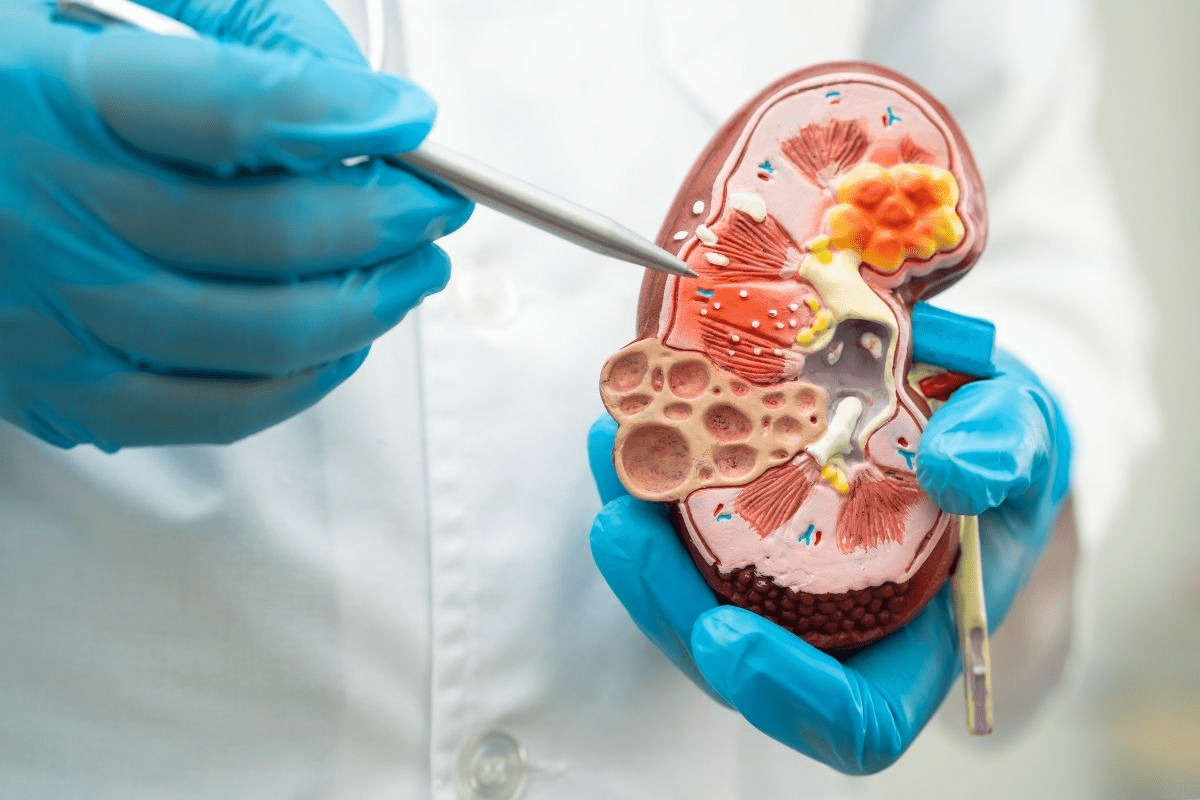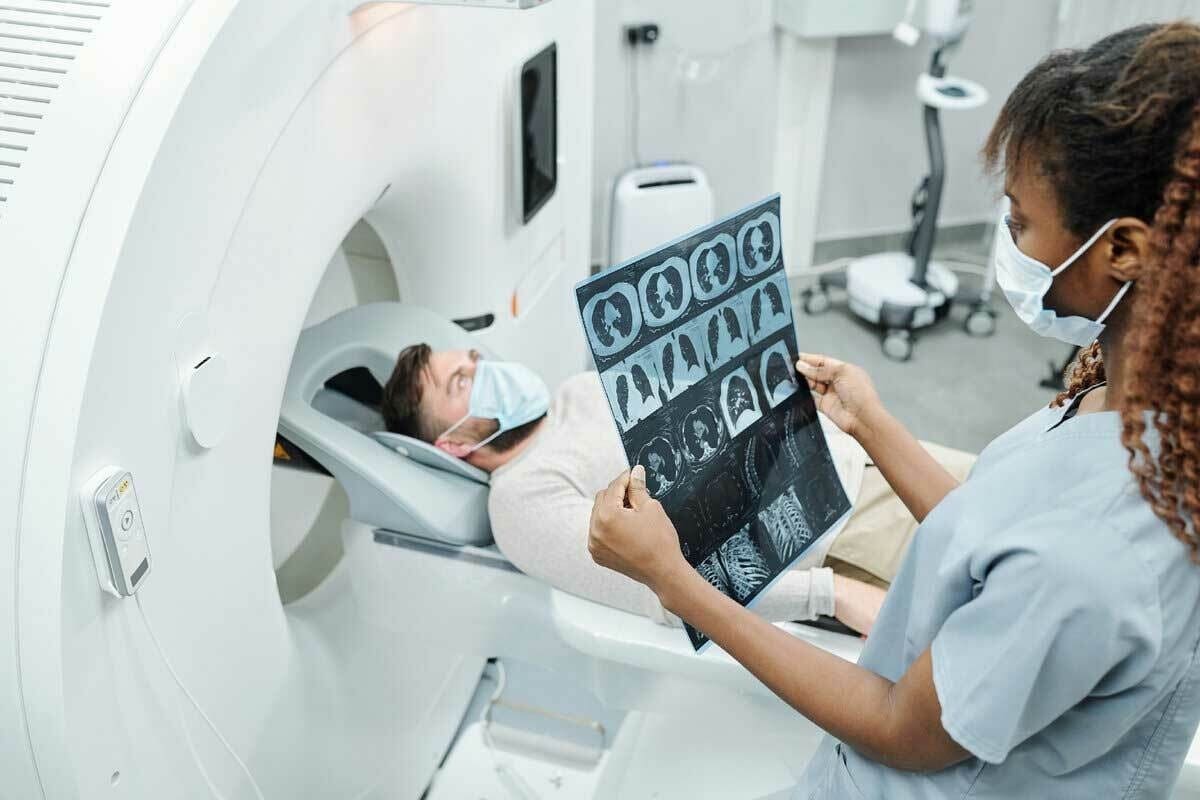Last Updated on November 26, 2025 by Bilal Hasdemir
Key Takeaways
- Understanding pain sources is vital for effective treatment.
- Abdominal and chest pain are common medical emergencies.
- Accurate diagnosis is key to managing pain effectively.
- Identifying the source of pain can be complex and challenging.
- Effective pain management relies on precise identification of pain origin.
Knowing where pain comes from is key to helping patients. Pain tells us something is wrong in our bodies. It’s important to figure out where and why we’re feeling pain to treat it right.
The Diagnostic Value of Accurate Pain Description
Telling a doctor exactly how you feel is very important. They use what you say to find out what’s wrong. For example, sharp pain might mean nerve damage, while dull pain could be from something chronic.
When you describe your pain, include how bad it is, how long it lasts, and what makes it better or worse. This helps doctors decide what tests to run and how to treat you.
How Pain Location Affects Treatment Approaches
Where you feel pain also matters a lot. Different spots on your body can point to different problems. For instance, pain in the upper right belly might mean gallbladder trouble, while chest pain could be heart-related.
| Pain Location | Potential Causes | Treatment Approaches |
| Upper Abdomen | Gallstones, Gastritis | Medication, Surgery |
| Lower Back | Muscle Strain, Herniated Disc | Physical Therapy, Surgery |
| Chest | Cardiac Issues, Musculoskeletal Pain | Cardiac Medication, Pain Management |
Knowing where and how you feel pain helps doctors make better plans for you. By pinpointing pain sources, patients get more effective treatments, leading to better health.
It’s important for both patients and doctors to know about the different kinds of pain. Pain can show up in many ways, each telling us something about what’s causing it.
Sharp vs. Dull Pain Characteristics
Pain can be sharp or dull, depending on how it feels. Sharp pain is intense and stabbing, often from injury. It’s usually in one spot and can be very strong.
Dull pain feels more like a dull ache. It’s harder to find where it is and often comes from long-term problems or damage.
Knowing if pain is sharp or dull helps doctors figure out what’s wrong. For example, sharp chest pain might mean a heart attack. But dull chest pain could be from muscles or something less serious.
Radiating vs. Localized Pain Patterns
Pain can also be either radiating or localized. Localized pain stays in one place, like a sprained ankle. Radiating pain spreads out, like sciatica pain that goes from the back to the legs.
Knowing if pain is in one spot or spreads out helps doctors find the source. Pain that spreads often means nerves or other special pain paths are involved.

Acute vs. Chronic Pain Timeframes
Acute pain is short-term, from injuries or surgery. It goes away when the injury heals. Chronic pain lasts more than three months and can be hard to manage.
Chronic pain can be tough because it doesn’t always have a clear cause. It can really affect a person’s life, like in arthritis or fibromyalgia.
The Science Behind Pain Location
Understanding pain location is key to accurate diagnosis. It involves complex physiological processes that affect how we feel pain.
Pain Signal Pathways in the Body
Pain signal pathways are essential for grasping how pain travels in our bodies. When we feel pain, special nerve endings called nociceptors are activated. They send signals to the brain through the nervous system.
The process includes several important steps:
- Nociceptors detect painful stimuli and turn them into electrical signals.
- These signals travel to the spinal cord via peripheral nerves.
- The spinal cord processes the information and sends it to the brain.
- The brain then interprets the signals, allowing us to feel and locate pain.
Understanding Referred Pain Mechanisms
Referred pain happens when we feel pain in a different place than where it actually is. This is due to how our nervous system processes pain signals.
For example, Ioan Hepburn’s accident shows how pain can be felt in different places. Knowing about referred pain is vital for correct diagnosis.
- Chest pain that feels like it’s in the arm during a heart attack.
- Lower back pain that comes from kidney problems.
How Inflammation Affects Pain Perception
Inflammation greatly affects how we feel pain. When tissues get damaged or infected, the body’s inflammatory response kicks in. This releases chemicals that can make us feel more pain.
These chemicals can make our nerve endings more sensitive. So, even small things can hurt a lot.
Key factors that influence pain during inflammation include:
- Increased sensitivity of nociceptors.
- Enhanced pain signaling to the brain.
Pain Location Mapping and Body Regions
Pain mapping is key to finding where pain comes from. It helps doctors narrow down causes and plan treatments. Knowing how to map pain helps people tell doctors about their pain better.
Using Anatomical Landmarks to Pinpoint Pain
Anatomical landmarks are special points on the body for finding pain. They include bones, muscles, and other structures. For example, knowing where pain is in the belly can help find the cause. Spotting pain accurately is key for diagnosis.
Quadrant-Based Pain Assessment
The body is divided into quadrants for better pain checking. This is very helpful for belly pain. For instance, pain in the right lower quadrant might mean appendicitis.
| Quadrant | Common Pain Associations |
| Right Upper Quadrant | Liver or gallbladder issues |
| Left Upper Quadrant | Splenic or stomach problems |
| Right Lower Quadrant | Appendicitis |
| Left Lower Quadrant | Diverticulitis or issues with the left ovary |
Dermatome Maps and Their Significance
Dermatome maps show skin areas covered by nerves from certain spinal nerves. They are important for finding nerve pain. Knowing dermatomes helps spot nerve problems.
“The use of dermatome maps can significantly enhance the accuracy of diagnosing nerve-related pain by correlating pain patterns with specific nerve roots.”
Using landmarks, quadrant assessment, and dermatome maps helps doctors understand pain better. This leads to more accurate diagnoses and better treatments.
Upper Abdominal Pain: Possible Causes
Upper abdominal pain, or epigastric pain, can be from issues with the stomach, liver, or pancreas. Common causes include gastritis, peptic ulcers, and pancreatitis. Gastritis, for example, is inflammation of the stomach lining, often from infection or NSAIDs.
“The location and nature of the pain can provide valuable clues about its origin,” notes a gastroenterology expert. Conditions like gallstones can also cause upper abdominal pain, typically on the right side.
Lower Abdominal Pain: Common Origins
Lower abdominal pain can come from problems with the intestines, appendix, or reproductive organs. Conditions such as appendicitis, diverticulitis, and inflammatory bowel disease (IBD) are common causes. In women, lower abdominal pain can also be linked to menstrual cramps, ovarian cysts, or ectopic pregnancy.
- Appendicitis typically presents with pain that starts near the navel and then moves to the lower right abdomen.
- Diverticulitis involves inflammation of diverticula in the colon, often causing lower left abdominal pain.
Central Abdominal Pain Indicators
Central abdominal pain, located around the navel, can be a sign of conditions like small bowel obstruction or early appendicitis. This type of pain can also be linked to irritable bowel syndrome (IBS) or gastroenteritis.
“The nature of abdominal pain, whether it’s sharp, dull, constant, or intermittent, provides critical information for diagnosis.” – A gastrointestinal specialist.
Deciphering Chest Pain Origins
Chest pain can come from many places, like the heart, muscles, lungs, or stomach. Knowing where chest pain comes from is key to getting the right help.
Distinguishing Cardiac from Non-Cardiac Pain
“The most common cause of cardiac chest pain is coronary artery disease, which reduces blood flow to the heart muscle,” say doctors. Non-cardiac pain is less serious but must be looked into to find its cause.
Musculoskeletal Chest Pain Characteristics
- Pain that worsens with movement or palpation
- Tenderness in the chest area
- Pain that may be reproduced by pressing on the affected area
Respiratory and Digestive Causes of Chest Pain
Respiratory problems like pneumonia or pleurisy cause pain that gets worse with deep breaths. Stomach issues, like GERD or esophageal spasms, also lead to chest pain. These often come with heartburn or trouble swallowing.
Knowing the different types of chest pain helps people find the right medical help. It’s important to understand where pain comes from to get the best care.
Pinpointing Back Pain Sources
Finding out where back pain comes from is the first step to feeling better. Back pain can come from many sources, like muscle problems, structural issues, or nerve conditions. Knowing exactly where and what the pain feels like is key to figuring out the cause.
Upper Back Pain: Muscular vs. Organ-Related
Upper back pain is between the neck and the rib cage’s bottom. It can be from muscle strain or problems with organs. Muscle strain often happens from bad posture, too much use, or injury. Organ pain might be from issues with the lungs or gallbladder.
Middle Back Pain: Possible Causes
Middle back pain is less common but can have many causes. It might be from spinal deformities, muscle strain, or pain from other areas. Problems like scoliosis or kyphosis can also cause pain here.
Lower Back Pain: Structural vs. Nerve Issues
Lower back pain often comes from structural problems, like herniated discs or spinal stenosis. Nerve pain, or radiculopathy, happens when a nerve gets irritated or compressed. This can make pain spread down the legs.
| Back Pain Location | Potential Causes |
| Upper Back | Muscular strain, organ-related issues (lungs, gallbladder) |
| Middle Back | Spinal deformities, muscle strain, referred pain |
| Lower Back | Structural issues (herniated discs, spinal stenosis), nerve issues (radiculopathy) |
Determining Pelvic Pain Origins
Pelvic pain is a complex issue that can come from many places. The pelvic area has important organs like those in the reproductive, urinary, and gastrointestinal systems. These organs can all cause pain.
Reproductive System-Related Pain Patterns
Pain from the reproductive system can show up in different ways. In women, endometriosis, ovarian cysts, and ectopic pregnancy can lead to pelvic pain. This pain might follow the menstrual cycle or be constant.
Knowing these patterns helps figure out if reproductive system pain is the cause.
Urinary System Pain Indicators
Pain from the urinary system can be due to UTIs, kidney stones, or interstitial cystitis. Symptoms include painful urination, needing to urinate often, or seeing blood in the urine. Spotting these signs can help diagnose urinary system pain.
Gastrointestinal Causes of Pelvic Discomfort
The gastrointestinal tract can also cause pelvic pain. Issues like IBS, IBD, and diverticulitis can lead to discomfort. This pain might be linked to bowel movements, eating, or be ongoing. Finding out these causes is key to managing the pain.
Distinguishing Between Tissue Types in Pain Location
Pain can come from muscles, nerves, and joints. Each needs a special way to find and treat the problem. Knowing how pain acts in these areas helps find the cause and the right treatment.
Muscle Pain Characteristics and Common Locations
Muscle pain, or myalgia, feels like a dull ache or sharp stabbing. It happens when muscles are overused, strained, or hurt. You often feel it in the back, shoulders, and legs.
Characteristics of muscle pain:
- Dull or aching sensation
- Sharp pain upon movement or palpation
- Localized to a specific muscle group
Nerve Pain Identification and Pathways
Nerve pain, or neuropathic pain, feels sharp, shooting, or burning. It happens when nerves are damaged or pressed. Causes include herniated discs, spinal stenosis, or sciatica.
Nerve pain characteristics:
- Sharp, shooting, or burning sensation
- Radiates along the nerve pathway
- Can be accompanied by numbness, tingling, or weakness
Joint Pain Recognition and Assessment
Joint pain, or arthralgia, comes from inflammation, injury, or conditions like arthritis. It feels stiff, swollen, and hurts when you move the joint.
| Tissue Type | Pain Characteristics | Common Locations |
| Muscle | Dull ache, sharp pain on movement | Back, shoulders, legs |
| Nerve | Sharp, shooting, burning | Along nerve pathways (e.g., sciatica) |
| Joint | Stiffness, swelling, pain on movement | Knees, hips, hands, spine |
Knowing how pain acts in muscles, nerves, and joints helps find the problem. This way, people can get the right medical help.
Self-Assessment Techniques for Pain Location
Self-assessment techniques are key to finding where pain is. Using different tools and methods helps people understand their pain patterns. This is important for managing pain well.
Creating and Using Detailed Pain Diaries
Keeping a pain diary is a top self-assessment method. It involves writing down where, how bad, and what the pain feels like at different times. This helps spot patterns and possible causes.
- Record the location of pain using body maps or descriptions.
- Note the intensity of pain using numerical or visual scales.
- Document any factors that seem to influence pain, such as activities or medications.
By keeping a detailed pain diary, people can give their doctors important info. This info helps with diagnosis and treatment plans.
Numerical and Visual Pain Rating Scales
Pain rating scales are key for measuring pain intensity. The most common are the Numerical Rating Scale (NRS) and the Visual Analog Scale (VAS).
The NRS asks people to rate their pain from 0 to 10 or 0 to 100. 0 means “no pain” and the highest number means “worst possible pain.”
The VAS is a continuous scale. People mark their pain level on a line between “no pain” and “worst pain.”
Digital Applications for Pain Tracking
Today, many mobile applications help track pain. These apps often have diary features and add-ons like reminders and activity tracking.
- Look for apps that allow detailed pain recording.
- Consider apps that offer reminder functionalities for medication or appointments.
- Some apps integrate with wearable devices or health records, making them more useful.
Self-Palpation Techniques for Pain Assessment
Self-palpation means checking your own body for tender spots. It’s great for finding musculoskeletal pain.
To do self-palpation well:
- Gently press on different body areas to find tender spots.
- Compare both sides of the body to spot any differences.
- Notice any changes in pain or tenderness over time.
Self-palpation gives quick feedback. It helps people understand their pain better.
When to Seek Medical Help Based on Pain Location
Knowing the severity and where pain is can help decide if you need to see a doctor right away. Pain is a sign that something is wrong in your body. Knowing what your pain feels like can help you make smart choices about your health.
Emergency Pain Situations Requiring Immediate Care
Some pains need you to get medical help fast. These include:
- Severe abdominal pain that comes on suddenly, with vomiting, fever, or tenderness.
- Chest pain that spreads to the arm, neck, or jaw, which could mean a heart attack.
- Sudden severe headache, often called “the worst headache ever,” which could be a stroke or aneurysm sign.
- Severe trauma or injury, like from a car crash or fall, with intense pain or trouble moving.
Chronic Pain Patterns That Warrant Medical Evaluation
Chronic pain is pain that lasts over three months. But, some changes in chronic pain might mean you need to see a doctor:
- Pain that interferes with daily activities or sleep.
- Pain that changes in intensity or character, getting worse or sharper.
- Pain with other symptoms like numbness, tingling, or weakness.
Pain That Changes in Location or Intensity
Pain that moves or changes in intensity might mean there’s a problem that needs a doctor’s help. For example:
- Pain that moves or radiates to other parts of the body.
- Pain that increases in severity over time or with certain activities.
Talking about these changes with a healthcare provider can help get a correct diagnosis and treatment plan.
Effectively Communicating Pain Location to Healthcare Providers
Telling your healthcare provider where your pain is can really help. A cancer patient shared how important it is to give clear pain details. This helps doctors diagnose and treat you right.
Preparing for Your Medical Appointment
Get ready for your doctor’s visit by thinking about your pain. Keep a pain diary to note when and how bad your pain is. Also, write down what makes it better or worse. This info is super helpful at your appointment.
Use exact words to describe your pain. Saying it’s sharp, dull, aching, or stabbing helps doctors understand it better.
Using Precise Terminology to Describe Pain
Be specific when talking about your pain. Instead of just saying “I have a pain,” say “I have a sharp, stabbing pain in my lower back.” This helps doctors guess what might be causing it.
Answering Key Questions About Your Pain
Doctors often ask specific questions to get a better picture of your pain. Being ready to answer these can make your visit more useful. Some important questions are:
- Where is your pain located?
- How long have you been feeling this pain?
- On a scale of 1-10, how would you rate your pain?
- Does anything trigger or relieve your pain?
Answering these questions clearly helps your doctor understand your pain better. They can then create a good treatment plan for you.
Conclusion
Knowing where your pain is coming from is key to managing it well. When you can tell your doctor exactly where it hurts, they can help you better. This leads to treatments that really work.
Being able to say where you feel pain changes how doctors treat you. For example, show how fast finding pain’s source is important. It helps stop more damage and helps you heal faster.
FAQ
What is the significance of identifying the source of pain?
How do different characteristics of pain indicate different underlying causes?
Pain types like sharp or dull, and where it spreads or stays, hint at what’s wrong. For example, muscle, nerve, or joint issues might be the cause.
What are the different types of pain and their characteristics?
Pain can be sharp or dull, spread or stay in one spot, and last a short time or forever. Each type points to different problems, like inflammation or long-term pain.
How do pain signals get transmitted in the body?
Pain signals travel through the body in complex ways. Inflammation can change how we feel pain, affecting these pathways.
What is referred pain, and how does it occur?
Referred pain is felt in a wrong place because of how pain signals are sent and received. It’s a brain trick.
How can I identify the source of abdominal pain?
Where your belly hurts can tell you what’s wrong. Upper, lower, or middle pain points to different issues. Doctors look closely at these areas.
What are the different origins of chest pain?
Chest pain can come from the heart, muscles, lungs, or stomach. Knowing the type of pain helps figure out the cause.
How can I determine the source of back pain?
Back pain’s location and feel can show what’s wrong. It might be muscles, bones, or nerves. Doctors check the upper, middle, or lower back.
What are the different origins of pelvic pain?
Pelvic pain can be from the reproductive, urinary, or digestive systems. Where and how it feels helps find the cause.
How can I distinguish between muscle, nerve, and joint pain?
Different body parts feel pain in different ways. Muscle, nerve, and joint pain have unique signs and spots. This helps figure out what’s wrong.
What self-assessment techniques can I use to track my pain?
Tools like pain diaries and rating scales help track pain. Apps and touching the painful area also help understand and manage pain.
When should I seek medical help for my pain?
Get medical help for emergencies, long-term pain, or if pain changes. Knowing when to see a doctor is key to managing pain well.
How can I effectively communicate my pain to healthcare providers?
Prepare for doctor visits and use the right words to describe your pain. Answering important questions helps doctors understand and treat your pain right.






